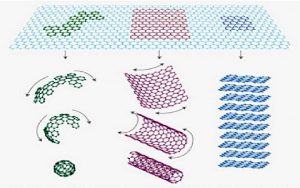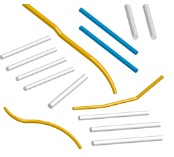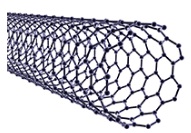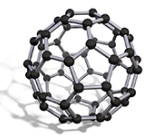Nanotechnology is the most common term which deals with nanoscale materials. This technology is to make use of minute objects. The property of the materials changes when the bulk is split into small sizes. The nanoscale materials possess unique properties in the fields of electronic, optical or mechanical, etc…Even in ancient days, these materials are used as dyes in ceramics. The insulators at the molecular stages can behave as conductors at this nanoscale. The behavior of the nanomaterials is based on the surface area rather than the composition present in the particle. The usage of the nanomaterials in the microprocessors leads to an increment in the density of the transistors.
What are Nanomaterials?
The particles are made with extremely tiny materials to possess unique physical as well as chemical properties is referred to as nanomaterial. The single dimension of this material is less or equivalent to 100 nanometers.

Nanomaterials
The same composition material from bulk to reduced in size by changing its conductivity and reactivity. The interaction or the presence of these materials in the biological systems leads to resulting in toxic effects on the living bodies.
The nano-sized particles are available in nature. It can be created from carbons or any minerals like silver. They must have the dimension lying from 1 nm to about 100 nm. The lab microscopes are used for observing these materials because they are not visible to the naked eye.
Properties
The quantum properties of the materials get affected as the sizes are reduced. The small size of these materials makes them free from internal imperfections present in structures and gain protection from mechanical failures. Even thermal and catalytic properties are observed once the bulk material is broken down to the nanoscale.
An increase in the ratio of the area of the surface to volume leads the system to become more reactive. These materials can rearrange the crystalline structure on dispersion.
Examples
In the field of cosmetics, the material called titanium oxide is used in the sunscreens. The field of sports utilizes nanotubes of carbons to produce bats used in baseball. Because the bats made from this will be lighter in weight resulting in the improvement of performance. Further, antimicrobial items like mats and towels are made using nanotechnology so that illness due to bacteria can be prevented and are used by sportspersons.
The systems made of sensors use nanomaterials called titanium dioxide in their development. It is helpful in the military to detect the presence of biological agents. The plastic chairs used in gardens uses the coatings of nanomaterial called titanium dioxide. A film on the creating is created so that any dirt is dissolved can be removed with the next shower. and cleans the chairs.
Classification of Nanomaterials
The classification of nanomaterials is based on various approaches. One of the approaches is based on the size of the material and they are classified as
Zero Dimension
These materials don’t have any dimensions. Point materials including oxides, semiconductors, quantum dots, hollow spheres, etc…

Zero Dimension Nanomaterials
One Dimension
The one billionth of any given unit that is a film of thin type is known as one dimension nanoparticles. It is used in engineering, electronics, chemistry, and so on for many decades. These are used in the construction of nanorods, nanowires, nanotubes, etc…

One Dimension
Two Dimension
This structure consists of two dimensions that are outside the range of nanometric size. It has characteristics dependent upon the shapes. Monolayer, Multilayer, Self- assembled, etc… comes under this category.

Two Dimension Nanomaterials
Three Dimension
In this, the structure consists of three dimensions. These are most widely used in magnetic materials, catalysts, and so on. These 3-D structures are further categorized as Fullerenes, Dendrimers, and Quantum Dots.

Three Dimension
From the classification, it is evident that the behavior of these particles is purely based on shapes, sizes, morphologies, and dimensions.
Advantages and Disadvantages of Nanomaterials
The advantages of the nanomaterials are:
- The small size of these materials offers the possibilities of manipulation easier, and multiple functions can be accommodated.
- Porosity is high in nanomaterials leads to an increase in its demand in the industries.
- The usage of these nanomaterials in the energy sector makes the existing methods of energy generation cost-effective and efficient.
- In the industry of electronics, the involvement of nanomaterial increases accuracy while constructing the circuits on atomic levels.
- The ratio of surface to volume is large enough in these materials permits the bonding of active ingredients and the cells.
- Compared to the coarsely grained ceramics, ceramics made of nanophase is more ductile during elevated temperatures.
The disadvantages of these materials are
- The exposure of nanomaterial due to inhalation. For example, materials like carbon nanofibers and nanotubes lead to Pulmonary Fibrosis examined from the animal study.
- Due to the no proper knowledge of these materials may cause the process of manufacturing to be difficult and complex.
- Nanoparticles are toxic to humans.
- The nanomaterials are unstable.
- The recycling of these materials is hard.
Please refer to this link for Nanomaterials MCQs
Applications
The application of nanomaterials are
Nanomaterials are utilized in various processes of manufacturing, health care, products as well as insulation, and so on. Some of the most important applications are listed as follows:
- The applications of bioimaging prefer these materials. Because these particles can possess to vary the intensity of the colors in the solutions. This is made possible by changing the thickness of the shell, the percentage of gold, and the aspect ratio.
- The nano-size particles such as gold will melt at lower temperatures in comparison to the bulkier ones.
- Nanomaterials are utilized in various processes of manufacturing, health care, products as well as insulation, and so on.
- Health care consisting of artificially developed enzymes are made from these nanomaterials. These enzymes are useful in the diagnosis of a tumor and biosensing
- The paints using materials protect from UV rays and are convenient during cleaning.
- These particles are also used in the technology of cosmetics.
Please refer to this link to know more about Nanotechnology MCQs.
Thus, this is all about an overview of Nanomaterials, which are known for various benefits technically. But some of those can lead to possible risks to the surrounding environment or human health. Therefore still scientific research is to be carried out regards to the safety and the usage of these materials. If in any situation nanoparticles enter the human then how it leaves the human body?